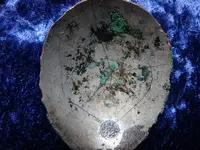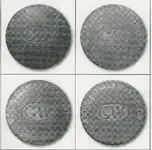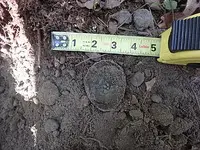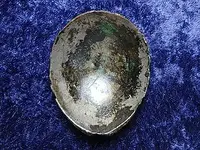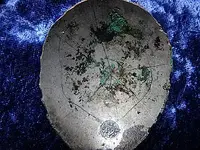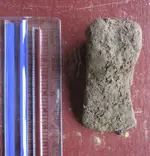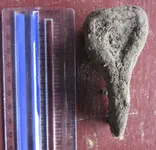Silver Tree Chaser
Bronze Member
17th Century New England Finds - Tomahawk, Brass Cut Fishing Spear, Points, & More!
This is a much needed catch up post for several outings at a 17th century site over the past month that I concluded yesterday. Each time before I could finish up a draft thread for the forum, I would manage another trip and another relevant find, so I apologize for this lengthy marathon post. Finds now have become increasingly scarce, and my neck stiffened up with a sprain of sorts today – too much wear and tear from all the digging. So, all good things must come to an end, but what an experience it was! All the finds point to a Native American encampment from the 17th century in New England. The site offered up a considerable number of lead shot of various calibers, but the surprising lack of brass kettle points seemingly indicated a near complete reliance on European muskets for hunting and fighting by the site’s occupants.
Along with numerous lead musket balls, I recovered bits of brass and iron fragments as well, but nothing whole or recognizable at first. In all my years of detecting, I had not recovered a brass arrow point, so the continued lack of success at this site was quite dismaying until I uncovered this thick piece of cut brass.
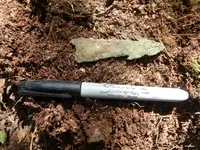
As this cut brass was recovered from an obvious wigwam site, it’s connection to Native technology is certain. Due to its specific size and shape, the identity of this find is quite obvious. Fashioned with one barb on one side and two barbs on the other side, it’s a three-inch fish spear or harpoon-type implement. Similar spears fashioned from bone or antler have been recovered, but I haven’t found an online match for a specimen of brass; nonetheless, I have the assurance of a highly-qualified archaeologist that it’s indeed a fishing spear and unique in its brass construction. Here’s a photo of the fish spear after being carefully cleaned.
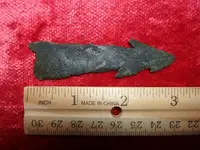
The specific area that produced the fish spear must have been a metal-working site of sorts, as only a few feet away I recovered this small brass decorative finial of a scallop along with other brass scraps. My guess is that appreciation for this piece saved it from being repurposed. It’s threaded, and if anyone has thoughts on what it came from, please post it here.
please post it here.
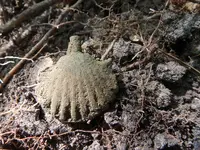
Encouraged by multiple finds, I soon made a return trip to this same exact spot and uncovered a wonderful pewter button. I was shocked by its considerable size but resisted the urge to examine it thoroughly; rather, I secured the delicate find in an air-tight plastic container with a few handfuls of dirt. As most of us know, long-buried pewter is very fragile. Upon returning home, I attended to its care like a surgeon. I quickly cleaned it with a toothpick and light brushing followed by a double dip in a mixture of 50/50 Elmer’s white glue and water. Here’s the end result.
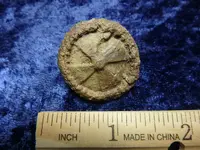
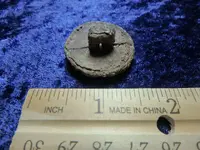
The appearance of a Maltese cross symbol on the button was surprising. I had expected a plain face on a button of that age. It’s incredibly thick, and the shank is intact. I don’t expect to uncover many decorative buttons of this quality and age anytime soon. As can be seen in the photo, the button is quite brittle, but I hadn’t lost a single flake of delaminating pewter due to careful handling and treatment.
I also uncovered an incomplete iron spur ravaged by exposure to the soil and the elements over the past three centuries. I plan on an electrolysis cook for the spur. Now, usually the recovery of annoying hot rocks while detecting is an unavoidable occurrence at times, but it’s a benefit at this site. The area is relatively clear of any rocks larger than an aspirin except for broken pieces of graphite, which my XP Deus hits on loud and clear. Here’s two such pieces of graphite. Note that one in worn smooth from frequent handling like a worry stone, while the other is broken along a flat plane.
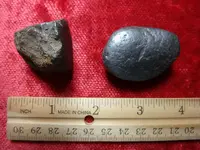
Now take a closer look at their side profiles in the next photo, and you’ll see that these pieces were worked, etched away with a sharp implement to obtain trimmed graphite 350+ years ago. I’ve researched this and learned that native tribes in New England used graphite to make black face paint for periods of mourning and perhaps other events. The graphite residue was mixed with bear fat and rubbed onto the skin. This graphite was carried onto the site by the Native occupants.
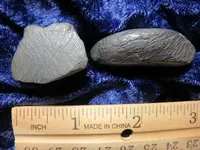
I located another area of finds nearby on my next trip. I first uncovered ferrous fragments and lead shot but soon came upon a larger signal. I open up a good size hole to avoid making any contact with my shovel and soon spotted a splendid 17th century latten spoon bowl; latten is an alloy of copper and zinc similar to brass.
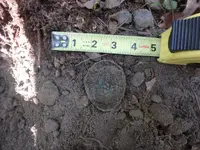
As is often the case, the spoon handle was missing, but I’m not complaining. Here’s an image of the spoon bowl as dug. The bowl itself was solid but covered with a thick coating of dirt and corrosion; no makers mark was visible at all. As with the pewter button, the spoon bowl went into an air-tight container right away. I then placed it in a bath of mineral oil when I returned home. I’m a big believer in the use of mineral oil for successfully treating dug coppers, brass buttons, buckles, and so forth. I’d probably buy it by the gallon on sale. Here’s the spoon bowl after a few days of being soaked in mineral oil, and I’m pleased with the results.
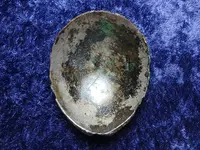
Certainly, the delicate use of a toothpick and brush was also needed to complete the needed work, but this couldn’t have been easier. Under magnification, I was able to remove all the built-up dirt and corrosion with the slight swipe of a toothpick, and then I noticed something. If you click on the above photo for an enlarged image, you’ll see what emerged to my view as I slowly cleaned away centuries of oxidation. An etched line, and another – actually four etched lines – all intersecting like the cardinal and intermediate points of a compass – north, north-east, east, southeast, and so forth. From what I’ve recently read,
An etched line, and another – actually four etched lines – all intersecting like the cardinal and intermediate points of a compass – north, north-east, east, southeast, and so forth. From what I’ve recently read,  eight-pointed stars or octograms have been used symbolically by various cultures around the world over the course of human history, including Native Americans, who used an eight-pointed star enclosed in a circle to symbolize hope, guidance, and protection. Now I saw the eight-pointed star on the spoon but had not taken the time to closely examine the engraving before texting photos to a detecting buddy. He later mentioned an outer circle engraved around the star pattern. I had seen some further etching but had not connected all the lines. He was right! The Algonquin who engraved the spoon had also included a circle in the design for a 17th century representation of a Native American hope symbol. If interested, here’s a link for information on the hope symbol.
eight-pointed stars or octograms have been used symbolically by various cultures around the world over the course of human history, including Native Americans, who used an eight-pointed star enclosed in a circle to symbolize hope, guidance, and protection. Now I saw the eight-pointed star on the spoon but had not taken the time to closely examine the engraving before texting photos to a detecting buddy. He later mentioned an outer circle engraved around the star pattern. I had seen some further etching but had not connected all the lines. He was right! The Algonquin who engraved the spoon had also included a circle in the design for a 17th century representation of a Native American hope symbol. If interested, here’s a link for information on the hope symbol.
https://www.warpaths2peacepipes.com/native-american-symbols/hope-symbol.htm#:~:text=The%20Native%20American%20Indians%20referred,providing%20hope%20for%20the%20future.&text=The%208%20pointed%20star%20symbolizes,Native%20American%20symbols%20signifies%20protection.
I confess to dismissing this apparent hope symbol as a simple geometric design absent of any outer circle, but now I am thinking otherwise. Online information for the Native Hope symbol is scarce – Pinterest, websites for symbols, and Native American jewelry. I’m not into any New Age practices. I don’t carry rock crystals in my pocket for good luck while detecting. I’m not into meditation or astrology, but the engraving on this spoon met something to someone a longtime ago.
The mineral oil soak has vastly improved the detail on the maker’s mark, which wasn’t even visible when the spoon was first found. Here’s a close-up of the mark.
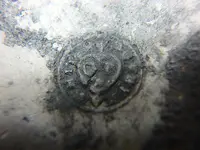
I think some light cleaning after a further soak will reveal further detail; however, I already have enough for an accurate identification. Here’s a partial image of a complete spoon from an auction a few years ago and an illustration of the mark from Old Base Metal Spoons by Frederick Price (2nd row, 2nd column); his book is online and invaluable as a reference source.
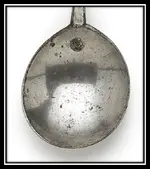
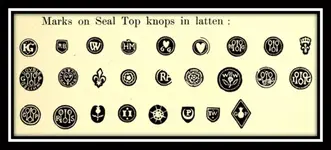
These sources date the spoon from the 1650s to the 1670s. The maker’s initials are GP enclosed in a heart with a piercing arrow. How’s that for ironic? A 17th century spoon bears an encircled eight-pointed star engraved by a Native American along with an image of a piercing arrow engraved by an Englishman. You would think that each individual was responsible for the alternate engraving, but that wasn’t the case. The maker’s mark includes the wording “DOUBLE WHITED” referring to a tin or silver wash. Some latten spoons would be dipped into molten tin to provide the flashy of fancy silver. This particular spoon was double dipped, and this process was quite effective as much of the tin wash survived 3 & ½ centuries in the ground!
As I mentioned, the recovery of finds soon began to falter – a musket ball here or there but little else. Yet two more finds awaited discovery, which I came upon largely by luck and opportune timing. On Friday the week before last, I was wrapping up an afternoon of hunting that produced no more than a few musket balls. As dusk was approaching, I roamed about hoping for a Hail Mary pass that only came to me after I had turned back to gather my bag of gear. At this site, I had been digging every repeatable signal – every chirp, click, and beep regardless of whether the tone was low, medium, or high. I had my XP Deus maxed out for sensitivity – DISC – 0.0, SENS – 95, IRON VOL – 5, REACT – 2. At the base of a small tree enclosed in brush, my coil caught a signal at the edge of my sweep. As I swept the target from multiple directions, I judged that it was the biggest and strongest target that I had encountered at the site, as if a 25-pound barbell plate was resting beneath the leaves. I cautiously cut a large hole, flipped the plug, and thankfully found that the signal was still coming from deep in the hole. I scooped a bit of dirt with my shovel and excitedly caught the sight of iron oxide, dark orange rust speckled in the dark soil as I felt around. Then I had it in my hand – a fantastic 17th century iron tomahawk.
hoping for a Hail Mary pass that only came to me after I had turned back to gather my bag of gear. At this site, I had been digging every repeatable signal – every chirp, click, and beep regardless of whether the tone was low, medium, or high. I had my XP Deus maxed out for sensitivity – DISC – 0.0, SENS – 95, IRON VOL – 5, REACT – 2. At the base of a small tree enclosed in brush, my coil caught a signal at the edge of my sweep. As I swept the target from multiple directions, I judged that it was the biggest and strongest target that I had encountered at the site, as if a 25-pound barbell plate was resting beneath the leaves. I cautiously cut a large hole, flipped the plug, and thankfully found that the signal was still coming from deep in the hole. I scooped a bit of dirt with my shovel and excitedly caught the sight of iron oxide, dark orange rust speckled in the dark soil as I felt around. Then I had it in my hand – a fantastic 17th century iron tomahawk.
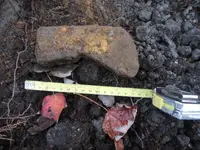
Measuring just over six inches in length, it was the ideal size for a hatchet, a weapon of an Algonquin brave, and it was awesome! In my 35 years of detecting, I’ve never found any manner of a sword-type weapon; this tomahawk will more than make up for any lack of bladed weapon recoveries.
In my 35 years of detecting, I’ve never found any manner of a sword-type weapon; this tomahawk will more than make up for any lack of bladed weapon recoveries.
Here’s photos of the tomahawk after some light cleaning with a toothpick and brush. I saved the dirt that came off the tomahawk; yeah, I know it’s a bit of overkill. While most of the dirt was dark, the light-colored, grainy dirt came from the eyelet; it’s remnants of the wood handle. I will be treating the tomahawk with electrolysis in the near future. If anyone has recommendations on buying wax – what type and were to purchase – I would like to hear about it. Is anyone familiar with Witco 180M microcrystalline wax?
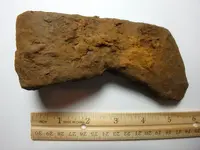
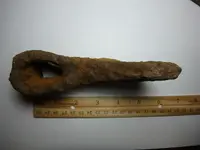
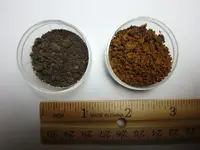
The second unexpected discovery to close out my search came yesterday. Again, an entire day of searching produced several musket balls and nothing more. Near the end of the day, I decided to work the outer edge of the first area that produced the fishing spear, but as I swept along, my detector hit on a target in the exact area where I found the spear. I dug a small fragment of iron, but then chanced upon another signal, a small copper tack. One of my detecting buddies was with me, and we puzzled over how I had missed these targets during my prior searches. As I dug a third signal, it occurred to me that we had recently had some significant rainfall after weeks of drought conditions. Owing to the recent rains, the soil had gone from a matrix similar to dry pancake mix to 10” plugs of damp soil and all-around better sensitivity for metal detecting. And that third signal? Those many years of detecting without the recovery of a cut brass arrow point ended abruptly – twice. Out of the hole, came one small brass point. After snapping a few photos, I rechecked the hole and out came another brass point encased in a thick layer of dirt! It was now approaching dusk, and I quickly dug one last signal before we left. It was another brass tack, a larger tack more comparable to a nail in size. It had a curious purposeful bend which I didn’t initially recognize. Then I realized it was modified for use as a pipe tamper for packing tobacco in a brave’s pipe. I’m certain of it. These finds offered an amazing turn of events right at the end of a long day!

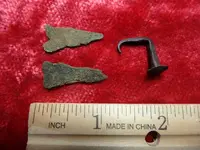
Here’s a group shot of the highlight finds. As I took the photo a few days ago, the brass points aren’t included, but the aforementioned iron spur is in the upper right corner.
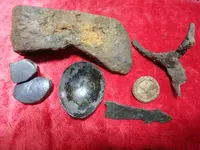
The finds amazingly date back to a time when the Americas was still very much a New World. These recoveries also offer poignant testimony to the allure of European goods for Native tribes. Demand for and dependence upon these same goods were a harbinger of soon-to-come conflict and inevitable, drastic change.
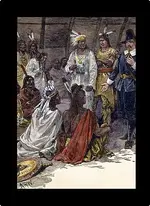
It’s a privilege to recover the lost history of such a momentous time.
Good Hunting!
This is a much needed catch up post for several outings at a 17th century site over the past month that I concluded yesterday. Each time before I could finish up a draft thread for the forum, I would manage another trip and another relevant find, so I apologize for this lengthy marathon post. Finds now have become increasingly scarce, and my neck stiffened up with a sprain of sorts today – too much wear and tear from all the digging. So, all good things must come to an end, but what an experience it was! All the finds point to a Native American encampment from the 17th century in New England. The site offered up a considerable number of lead shot of various calibers, but the surprising lack of brass kettle points seemingly indicated a near complete reliance on European muskets for hunting and fighting by the site’s occupants.
Along with numerous lead musket balls, I recovered bits of brass and iron fragments as well, but nothing whole or recognizable at first. In all my years of detecting, I had not recovered a brass arrow point, so the continued lack of success at this site was quite dismaying until I uncovered this thick piece of cut brass.

As this cut brass was recovered from an obvious wigwam site, it’s connection to Native technology is certain. Due to its specific size and shape, the identity of this find is quite obvious. Fashioned with one barb on one side and two barbs on the other side, it’s a three-inch fish spear or harpoon-type implement. Similar spears fashioned from bone or antler have been recovered, but I haven’t found an online match for a specimen of brass; nonetheless, I have the assurance of a highly-qualified archaeologist that it’s indeed a fishing spear and unique in its brass construction. Here’s a photo of the fish spear after being carefully cleaned.

The specific area that produced the fish spear must have been a metal-working site of sorts, as only a few feet away I recovered this small brass decorative finial of a scallop along with other brass scraps. My guess is that appreciation for this piece saved it from being repurposed. It’s threaded, and if anyone has thoughts on what it came from,
 please post it here.
please post it here. 
Encouraged by multiple finds, I soon made a return trip to this same exact spot and uncovered a wonderful pewter button. I was shocked by its considerable size but resisted the urge to examine it thoroughly; rather, I secured the delicate find in an air-tight plastic container with a few handfuls of dirt. As most of us know, long-buried pewter is very fragile. Upon returning home, I attended to its care like a surgeon. I quickly cleaned it with a toothpick and light brushing followed by a double dip in a mixture of 50/50 Elmer’s white glue and water. Here’s the end result.


The appearance of a Maltese cross symbol on the button was surprising. I had expected a plain face on a button of that age. It’s incredibly thick, and the shank is intact. I don’t expect to uncover many decorative buttons of this quality and age anytime soon. As can be seen in the photo, the button is quite brittle, but I hadn’t lost a single flake of delaminating pewter due to careful handling and treatment.
I also uncovered an incomplete iron spur ravaged by exposure to the soil and the elements over the past three centuries. I plan on an electrolysis cook for the spur. Now, usually the recovery of annoying hot rocks while detecting is an unavoidable occurrence at times, but it’s a benefit at this site. The area is relatively clear of any rocks larger than an aspirin except for broken pieces of graphite, which my XP Deus hits on loud and clear. Here’s two such pieces of graphite. Note that one in worn smooth from frequent handling like a worry stone, while the other is broken along a flat plane.

Now take a closer look at their side profiles in the next photo, and you’ll see that these pieces were worked, etched away with a sharp implement to obtain trimmed graphite 350+ years ago. I’ve researched this and learned that native tribes in New England used graphite to make black face paint for periods of mourning and perhaps other events. The graphite residue was mixed with bear fat and rubbed onto the skin. This graphite was carried onto the site by the Native occupants.

I located another area of finds nearby on my next trip. I first uncovered ferrous fragments and lead shot but soon came upon a larger signal. I open up a good size hole to avoid making any contact with my shovel and soon spotted a splendid 17th century latten spoon bowl; latten is an alloy of copper and zinc similar to brass.

As is often the case, the spoon handle was missing, but I’m not complaining. Here’s an image of the spoon bowl as dug. The bowl itself was solid but covered with a thick coating of dirt and corrosion; no makers mark was visible at all. As with the pewter button, the spoon bowl went into an air-tight container right away. I then placed it in a bath of mineral oil when I returned home. I’m a big believer in the use of mineral oil for successfully treating dug coppers, brass buttons, buckles, and so forth. I’d probably buy it by the gallon on sale. Here’s the spoon bowl after a few days of being soaked in mineral oil, and I’m pleased with the results.

Certainly, the delicate use of a toothpick and brush was also needed to complete the needed work, but this couldn’t have been easier. Under magnification, I was able to remove all the built-up dirt and corrosion with the slight swipe of a toothpick, and then I noticed something. If you click on the above photo for an enlarged image, you’ll see what emerged to my view as I slowly cleaned away centuries of oxidation.
https://www.warpaths2peacepipes.com/native-american-symbols/hope-symbol.htm#:~:text=The%20Native%20American%20Indians%20referred,providing%20hope%20for%20the%20future.&text=The%208%20pointed%20star%20symbolizes,Native%20American%20symbols%20signifies%20protection.
I confess to dismissing this apparent hope symbol as a simple geometric design absent of any outer circle, but now I am thinking otherwise. Online information for the Native Hope symbol is scarce – Pinterest, websites for symbols, and Native American jewelry. I’m not into any New Age practices. I don’t carry rock crystals in my pocket for good luck while detecting. I’m not into meditation or astrology, but the engraving on this spoon met something to someone a longtime ago.
The mineral oil soak has vastly improved the detail on the maker’s mark, which wasn’t even visible when the spoon was first found. Here’s a close-up of the mark.

I think some light cleaning after a further soak will reveal further detail; however, I already have enough for an accurate identification. Here’s a partial image of a complete spoon from an auction a few years ago and an illustration of the mark from Old Base Metal Spoons by Frederick Price (2nd row, 2nd column); his book is online and invaluable as a reference source.


These sources date the spoon from the 1650s to the 1670s. The maker’s initials are GP enclosed in a heart with a piercing arrow. How’s that for ironic? A 17th century spoon bears an encircled eight-pointed star engraved by a Native American along with an image of a piercing arrow engraved by an Englishman. You would think that each individual was responsible for the alternate engraving, but that wasn’t the case. The maker’s mark includes the wording “DOUBLE WHITED” referring to a tin or silver wash. Some latten spoons would be dipped into molten tin to provide the flashy of fancy silver. This particular spoon was double dipped, and this process was quite effective as much of the tin wash survived 3 & ½ centuries in the ground!

As I mentioned, the recovery of finds soon began to falter – a musket ball here or there but little else. Yet two more finds awaited discovery, which I came upon largely by luck and opportune timing. On Friday the week before last, I was wrapping up an afternoon of hunting that produced no more than a few musket balls. As dusk was approaching, I roamed about
 hoping for a Hail Mary pass that only came to me after I had turned back to gather my bag of gear. At this site, I had been digging every repeatable signal – every chirp, click, and beep regardless of whether the tone was low, medium, or high. I had my XP Deus maxed out for sensitivity – DISC – 0.0, SENS – 95, IRON VOL – 5, REACT – 2. At the base of a small tree enclosed in brush, my coil caught a signal at the edge of my sweep. As I swept the target from multiple directions, I judged that it was the biggest and strongest target that I had encountered at the site, as if a 25-pound barbell plate was resting beneath the leaves. I cautiously cut a large hole, flipped the plug, and thankfully found that the signal was still coming from deep in the hole. I scooped a bit of dirt with my shovel and excitedly caught the sight of iron oxide, dark orange rust speckled in the dark soil as I felt around. Then I had it in my hand – a fantastic 17th century iron tomahawk.
hoping for a Hail Mary pass that only came to me after I had turned back to gather my bag of gear. At this site, I had been digging every repeatable signal – every chirp, click, and beep regardless of whether the tone was low, medium, or high. I had my XP Deus maxed out for sensitivity – DISC – 0.0, SENS – 95, IRON VOL – 5, REACT – 2. At the base of a small tree enclosed in brush, my coil caught a signal at the edge of my sweep. As I swept the target from multiple directions, I judged that it was the biggest and strongest target that I had encountered at the site, as if a 25-pound barbell plate was resting beneath the leaves. I cautiously cut a large hole, flipped the plug, and thankfully found that the signal was still coming from deep in the hole. I scooped a bit of dirt with my shovel and excitedly caught the sight of iron oxide, dark orange rust speckled in the dark soil as I felt around. Then I had it in my hand – a fantastic 17th century iron tomahawk.
Measuring just over six inches in length, it was the ideal size for a hatchet, a weapon of an Algonquin brave, and it was awesome!
 In my 35 years of detecting, I’ve never found any manner of a sword-type weapon; this tomahawk will more than make up for any lack of bladed weapon recoveries.
In my 35 years of detecting, I’ve never found any manner of a sword-type weapon; this tomahawk will more than make up for any lack of bladed weapon recoveries. Here’s photos of the tomahawk after some light cleaning with a toothpick and brush. I saved the dirt that came off the tomahawk; yeah, I know it’s a bit of overkill. While most of the dirt was dark, the light-colored, grainy dirt came from the eyelet; it’s remnants of the wood handle. I will be treating the tomahawk with electrolysis in the near future. If anyone has recommendations on buying wax – what type and were to purchase – I would like to hear about it. Is anyone familiar with Witco 180M microcrystalline wax?



The second unexpected discovery to close out my search came yesterday. Again, an entire day of searching produced several musket balls and nothing more. Near the end of the day, I decided to work the outer edge of the first area that produced the fishing spear, but as I swept along, my detector hit on a target in the exact area where I found the spear. I dug a small fragment of iron, but then chanced upon another signal, a small copper tack. One of my detecting buddies was with me, and we puzzled over how I had missed these targets during my prior searches. As I dug a third signal, it occurred to me that we had recently had some significant rainfall after weeks of drought conditions. Owing to the recent rains, the soil had gone from a matrix similar to dry pancake mix to 10” plugs of damp soil and all-around better sensitivity for metal detecting. And that third signal? Those many years of detecting without the recovery of a cut brass arrow point ended abruptly – twice. Out of the hole, came one small brass point. After snapping a few photos, I rechecked the hole and out came another brass point encased in a thick layer of dirt! It was now approaching dusk, and I quickly dug one last signal before we left. It was another brass tack, a larger tack more comparable to a nail in size. It had a curious purposeful bend which I didn’t initially recognize. Then I realized it was modified for use as a pipe tamper for packing tobacco in a brave’s pipe. I’m certain of it. These finds offered an amazing turn of events right at the end of a long day!

Here’s a group shot of the highlight finds. As I took the photo a few days ago, the brass points aren’t included, but the aforementioned iron spur is in the upper right corner.

The finds amazingly date back to a time when the Americas was still very much a New World. These recoveries also offer poignant testimony to the allure of European goods for Native tribes. Demand for and dependence upon these same goods were a harbinger of soon-to-come conflict and inevitable, drastic change.

It’s a privilege to recover the lost history of such a momentous time.
Good Hunting!
Last edited:
Upvote
59




 ... Mmmmmk.... we are gonna tread some deep water with this.
... Mmmmmk.... we are gonna tread some deep water with this.
